by Jason Bodner
February 25, 2025
Most of the country is currently in a deep freeze – except south Florida, where I live. Sorry about that!
But February in the southern-hemisphere is in the last month of their summer, so it is warm down there.
The calendar says we are more than halfway through the first quarter, so this is a good time to do a market check-up. First, let’s check on earnings for the S&P 503. No, that’s not a typo: The S&P 500 has over 500 stocks in it. According to FactSet and several other data providers I use, the S&P index contains as many as 503 stocks. Mainly, this is because some companies have duplicates. For instance, Google has two classes with different tickers: GOOG and GOOGL – the same company but two with stocks in the index.
According to FactSet, as of this writing, 86% of the S&P 500 had reported earnings. Approximately 76% of companies have beaten earnings while 62% have beaten sales – right in line with the 10-year average:
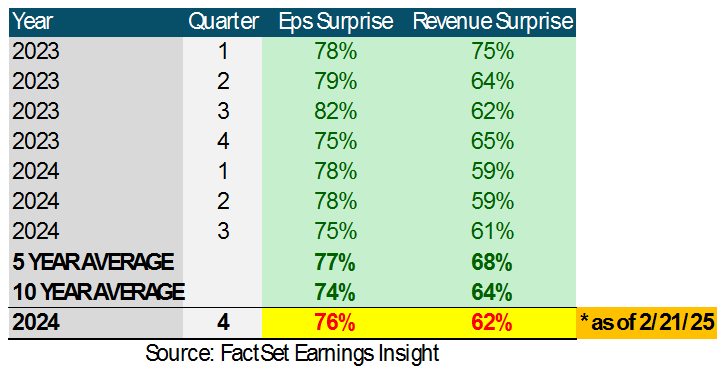
Graphs are for illustrative and discussion purposes only. Please read important disclosures at the end of this commentary.
Earnings growth is beating predictions in 7 of the 11 S&P sectors thus far. Financials companies are seeing the most growth, followed by discretionary companies. Interestingly, technology stocks thus far have seen earnings growth under predictions. That can change once NVDA (I own shares) reports tomorrow. Energy is the lone earnings contracting sector, but it deals with seasonality and volatile oil prices:


FactSet
Graphs are for illustrative and discussion purposes only. Please read important disclosures at the end of this commentary.
Interestingly, earnings growth doesn’t always drive share prices – immediately, anyway.
Next, we check in on all sorts of index performance since the start of the year. Some things stand out.
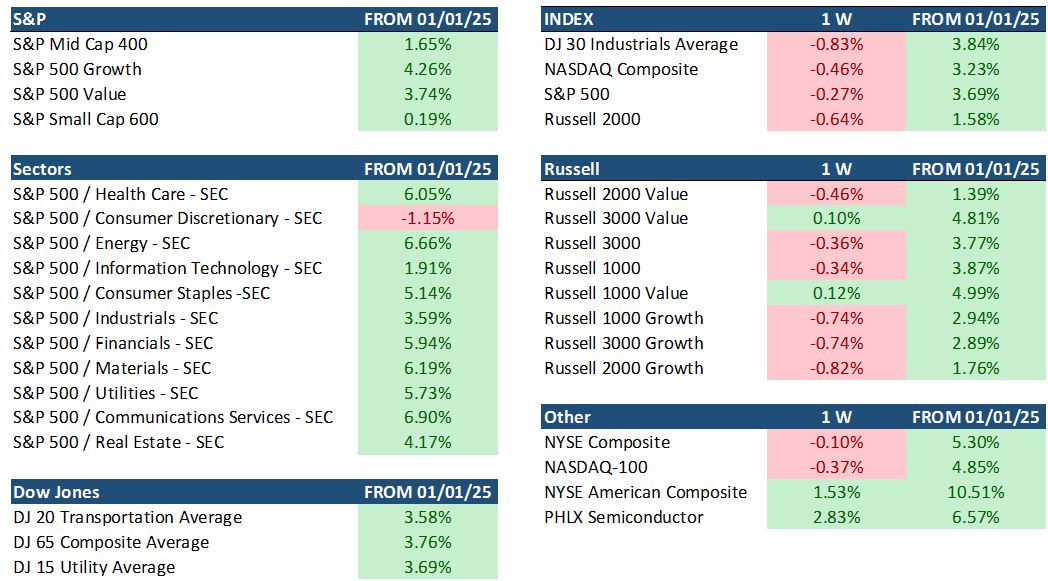
Graphs are for illustrative and discussion purposes only. Please read important disclosures at the end of this commentary.
Here are some highlights:
- Energy; despite experiencing earnings contraction, is up 6.66%.
- Health Care; one of the weakest recent sectors, is up 6.05%.
- Discretionary stocks; posting what looks to be the biggest beat of earnings growth predictions, is down 1.15% since January 1st.
- Technology; the engine of growth I like to see power bull markets, is only up modestly, +1.9%.
- Most Growth indexes are up nicely.
- The small cap heavy Russell 2000 is the lagging index – while still being up 1.58%.
- Semi-conductors are performing nicely: +6.57%.
That said, if we look from the beginning of February, we only see mediocre index performance:
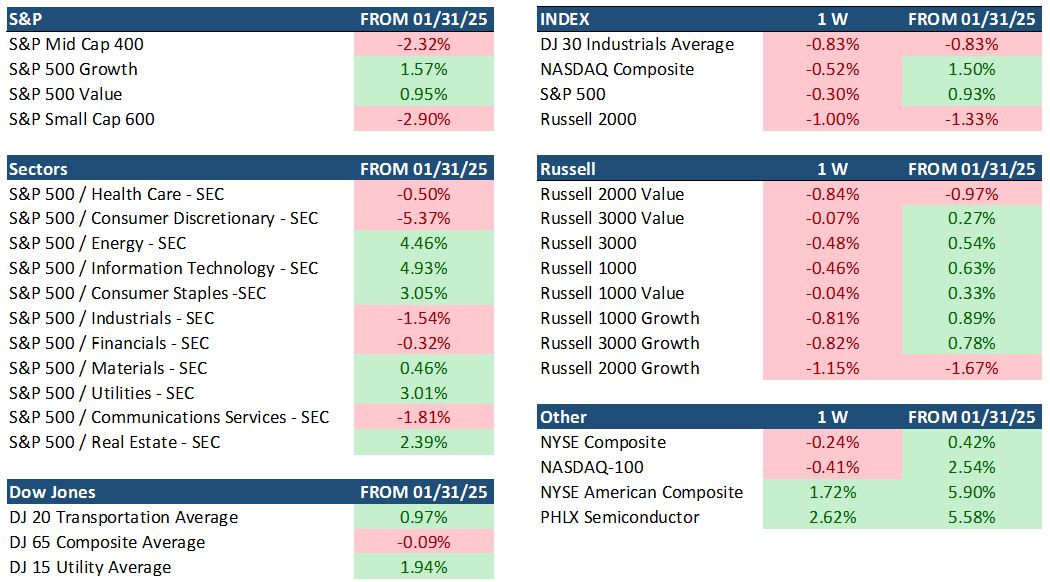
Graphs are for illustrative and discussion purposes only. Please read important disclosures at the end of this commentary.
This push-pull of sector performance impacts MAPsignals’ sector strength and weakness, but remember, strength and weakness are also a factor in fundamentals, like sales and earnings growth, and profitability:
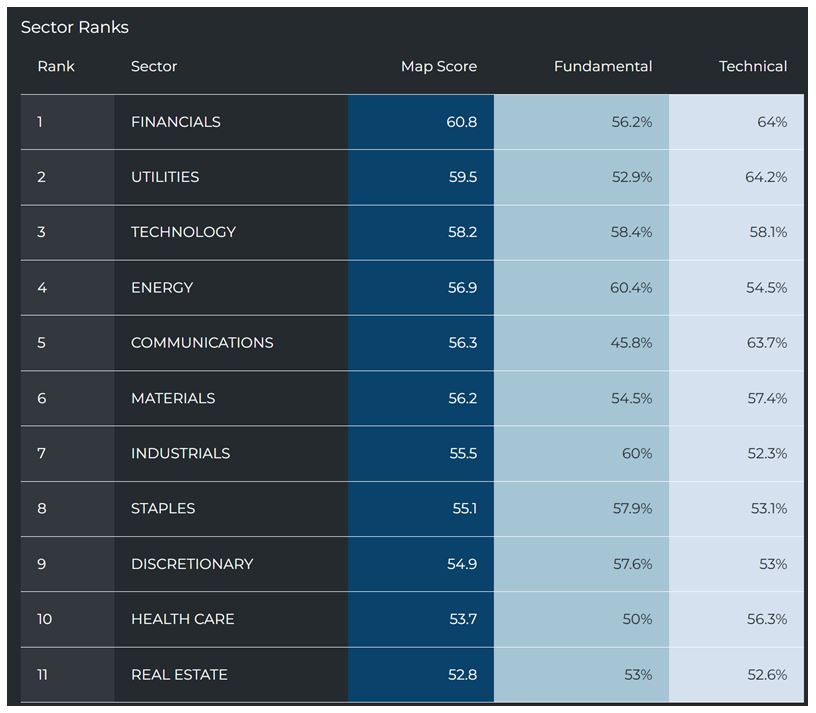
Graphs are for illustrative and discussion purposes only. Please read important disclosures at the end of this commentary.
When we look at inflows and outflows, we see steady, but not heavy, inflows into financials stocks, a sector that is clearly rising in price, but the bulky big inflows took place months ago. Utilities stocks are seeing rising-inflows and dwindling-outflows, pushing the sector higher.
Technology is interesting in that it is seeing both increasing inflows and outflows. That indicates a tug of war within the sector, and, as we see below, this results in sideways sector price action:


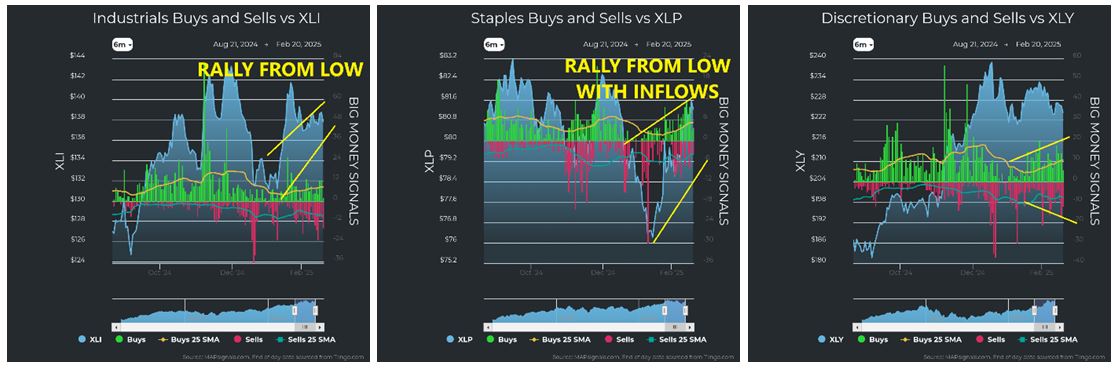
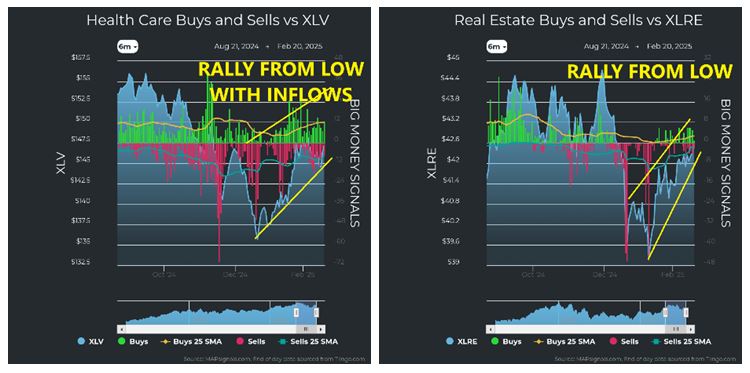
Graphs are for illustrative and discussion purposes only. Please read important disclosures at the end of this commentary.
Financials, Technology, Communications, and Discretionary are sectors trading at or near recent highs. Those are positive engines of sustained bull markets. The other sectors are less strong but still showing positive action. Energy, Materials, Industrials, Staples, Health Care, and even Real Estate are rallying from lows.
We have been seeing balanced inflows and outflows since January 1st. That indicates a rotation and tug of war below the surface of the market. We also see sustained buying in mid-cap companies ($5-50 billion):
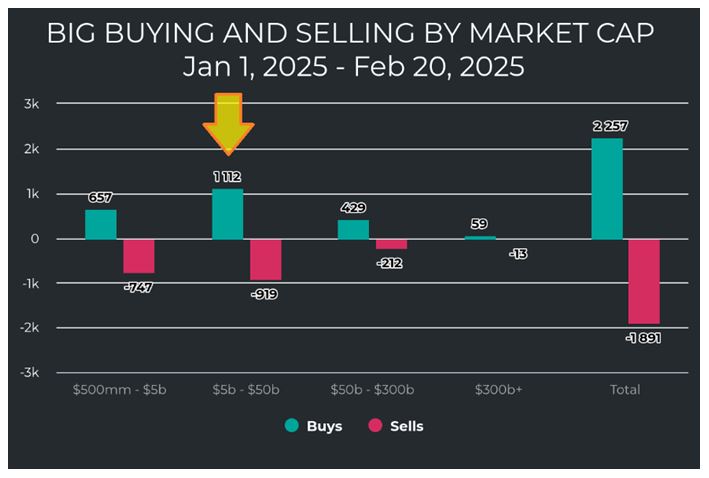
Graphs are for illustrative and discussion purposes only. Please read important disclosures at the end of this commentary.
The tug of war can be seen in inflows and outflows at the industry and sub-industry level.
Here’s a look at those industrial inflows and outflows by industry within key sectors:
Discretionary:
- Inflows: Hospitality Services (entertainment, hotels, restaurants and bars)
- Outflows: Hospitality Services (restaurants and bars, footwear producers)
Financials:
- Inflows: Investment Services (consumer finance, securities sales and trading, financial software)
- Outflows: Insurance (property and casualty)
Health Care:
- Outflows: System Specific Bio-pharmaceuticals
Staples:
- Outflows: Food and Beverage Production
Technology:
- Inflows: Software, Internet and Data Services
- Outflows: Software, Semi-conductor Manufacturing (enterprise management software)
Real Estate:
- Outflows: Equity REITs
The news tells us that investors are souring on the economy and it’s time for risk-off. That’s all possible, but the S&P 500 is only 2% down from all-time highs made just two days ago, and it’s only down 0.45% for the month, so let’s take “souring” with a grain of salt. Fears are surfacing that Trump’s aggressive action and sweeping change in federal employment will push us into recession. Perhaps, but perhaps not.
For now, stocks have sold-off slightly from all-time highs. That, in my opinion, is to be expected. As we cap off earnings season, the market is tired and needs a little rest. It’s only natural to see a little give-back.
Stocks have seen more inflows than outflows. Lately, outflows are picking up ever so slightly and we are heading into a period between earnings seasons. Historically, that’s when volatility can strike from nowhere, as there are fewer company-related headlines to take up the market oxygen.
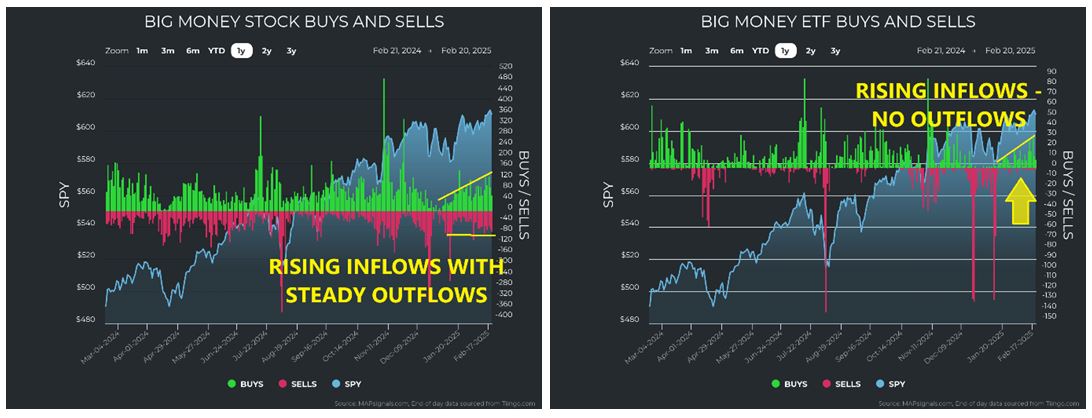
Graphs are for illustrative and discussion purposes only. Please read important disclosures at the end of this commentary.
It is also positive that volumes have been healthy as the market goes higher. This indicates that real inflows are pushing values higher, as opposed to drifting higher on thin volumes:
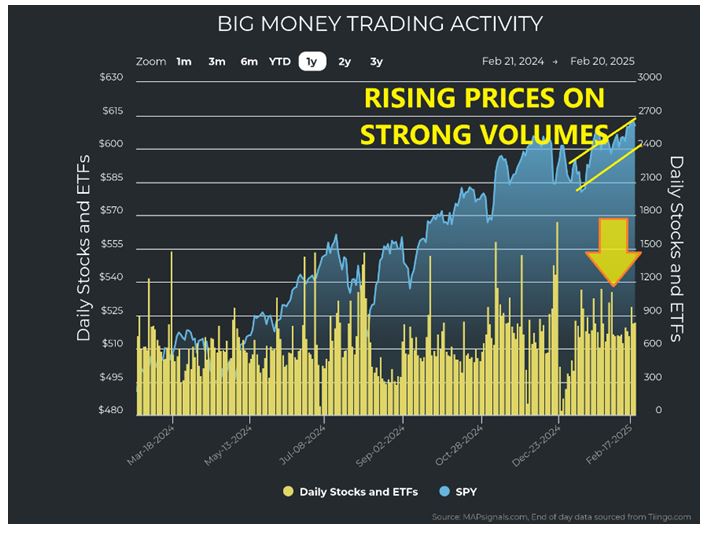
Graphs are for illustrative and discussion purposes only. Please read important disclosures at the end of this commentary.
All of this has had a positive effect on the Big Money Index:

Graphs are for illustrative and discussion purposes only. Please read important disclosures at the end of this commentary.
This all seems promising until we review one glaring statistic: as of the Friday February 21st close, 48.5% of the S&P 500 stocks closed below their 50-day moving average. This is a sign of a weakening market. We will have to keep an eye on this, as this could be a sign of a reversal. For now, the silver lining is that only 41% of the S&P 500 is trading below their 200-day moving average.
Friday February 21st saw a sloppy trading session where indexes sank:
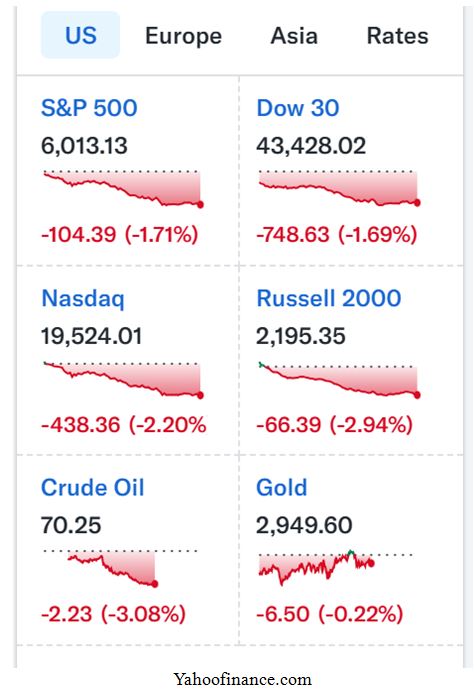
Graphs are for illustrative and discussion purposes only. Please read important disclosures at the end of this commentary.
The market is still near all-time highs. Signs of potential weakness are to be expected. Nothing goes straight up forever. But in looking over 100-years, stocks usually rise – plain and simple.
Keep vigilant; the tides haven’t turned quite yet.
“If a man knows not to which port he sails, no wind is favorable.” – Seneca
Navellier & Associates own; Alphabet Inc. Class A & C (GOOG,GOOGL), and Nvidia Corp (NVDA), in managed accounts. Jason Bodner owns; Nvidia Corp (NVDA), in a personal account. He does not personally own Alphabet Inc. Class A & C (GOOG,GOOGL).
All content above represents the opinion of Jason Bodner of Navellier & Associates, Inc.
Also In This Issue
A Look Ahead by Louis Navellier
As U.S. Relations Thaw with Putin, a Chill Falls Over Europe
Income Mail by Bryan Perry
Taking Stock of Trump’s Tough Tariff Talk
Growth Mail by Gary Alexander
All Hail February 25th – a Red-Letter Day in U.S. Financial History
Global Mail by Ivan Martchev
The Friday Curse of the S&P 500
Sector Spotlight by Jason Bodner
A Mid-Quarter S&P Sector Review
View Full Archive
Read Past Issues Here

Jason Bodner
MARKETMAIL EDITOR FOR SECTOR SPOTLIGHT
Jason Bodner writes Sector Spotlight in the weekly Marketmail publication and has authored several white papers for the company. He is also Co-Founder of Macro Analytics for Professionals which produces proprietary equity accumulation and distribution research for its clients. Previously, Mr. Bodner served as Director of European Equity Derivatives for Cantor Fitzgerald Europe in London, then moved to the role of Head of Equity Derivatives North America for the same company in New York. He also served as S.V.P. Equity Derivatives for Jefferies, LLC. He received a B.S. in business administration in 1996, with honors, from Skidmore College as a member of the Periclean Honors Society. All content of “Sector Spotlight” represents the opinion of Jason Bodner
Important Disclosures:
Jason Bodner is a co-founder and co-owner of Mapsignals. Mr. Bodner is an independent contractor who is occasionally hired by Navellier & Associates to write an article and or provide opinions for possible use in articles that appear in Navellier & Associates weekly Market Mail. Mr. Bodner is not employed or affiliated with Louis Navellier, Navellier & Associates, Inc., or any other Navellier owned entity. The opinions and statements made here are those of Mr. Bodner and not necessarily those of any other persons or entities. This is not an endorsement, or solicitation or testimonial or investment advice regarding the BMI Index or any statements or recommendations or analysis in the article or the BMI Index or Mapsignals or its products or strategies.
Although information in these reports has been obtained from and is based upon sources that Navellier believes to be reliable, Navellier does not guarantee its accuracy and it may be incomplete or condensed. All opinions and estimates constitute Navellier’s judgment as of the date the report was created and are subject to change without notice. These reports are for informational purposes only and are not a solicitation for the purchase or sale of a security. Any decision to purchase securities mentioned in these reports must take into account existing public information on such securities or any registered prospectus.To the extent permitted by law, neither Navellier & Associates, Inc., nor any of its affiliates, agents, or service providers assumes any liability or responsibility nor owes any duty of care for any consequences of any person acting or refraining to act in reliance on the information contained in this communication or for any decision based on it.
Past performance is no indication of future results. Investment in securities involves significant risk and has the potential for partial or complete loss of funds invested. It should not be assumed that any securities recommendations made by Navellier. in the future will be profitable or equal the performance of securities made in this report. Dividend payments are not guaranteed. The amount of a dividend payment, if any, can vary over time and issuers may reduce dividends paid on securities in the event of a recession or adverse event affecting a specific industry or issuer.
None of the stock information, data, and company information presented herein constitutes a recommendation by Navellier or a solicitation to buy or sell any securities. Any specific securities identified and described do not represent all of the securities purchased, sold, or recommended for advisory clients. The holdings identified do not represent all of the securities purchased, sold, or recommended for advisory clients and the reader should not assume that investments in the securities identified and discussed were or will be profitable.
Information presented is general information that does not take into account your individual circumstances, financial situation, or needs, nor does it present a personalized recommendation to you. Individual stocks presented may not be suitable for every investor. Investment in securities involves significant risk and has the potential for partial or complete loss of funds invested. Investment in fixed income securities has the potential for the investment return and principal value of an investment to fluctuate so that an investor’s holdings, when redeemed, may be worth less than their original cost.
One cannot invest directly in an index. Index is unmanaged and index performance does not reflect deduction of fees, expenses, or taxes. Presentation of Index data does not reflect a belief by Navellier that any stock index constitutes an investment alternative to any Navellier equity strategy or is necessarily comparable to such strategies. Among the most important differences between the Indices and Navellier strategies are that the Navellier equity strategies may (1) incur material management fees, (2) concentrate its investments in relatively few stocks, industries, or sectors, (3) have significantly greater trading activity and related costs, and (4) be significantly more or less volatile than the Indices.
ETF Risk: We may invest in exchange traded funds (“ETFs”) and some of our investment strategies are generally fully invested in ETFs. Like traditional mutual funds, ETFs charge asset-based fees, but they generally do not charge initial sales charges or redemption fees and investors typically pay only customary brokerage fees to buy and sell ETF shares. The fees and costs charged by ETFs held in client accounts will not be deducted from the compensation the client pays Navellier. ETF prices can fluctuate up or down, and a client account could lose money investing in an ETF if the prices of the securities owned by the ETF go down. ETFs are subject to additional risks:
- ETF shares may trade above or below their net asset value;
- An active trading market for an ETF’s shares may not develop or be maintained;
- The value of an ETF may be more volatile than the underlying portfolio of securities the ETF is designed to track;
- The cost of owning shares of the ETF may exceed those a client would incur by directly investing in the underlying securities and;
- Trading of an ETF’s shares may be halted if the listing exchange’s officials deem it appropriate, the shares are delisted from the exchange, or the activation of market-wide “circuit breakers” (which are tied to large decreases in stock prices) halts stock trading generally.
Grader Disclosures: Investment in equity strategies involves substantial risk and has the potential for partial or complete loss of funds invested. The sample portfolio and any accompanying charts are for informational purposes only and are not to be construed as a solicitation to buy or sell any financial instrument and should not be relied upon as the sole factor in an investment making decision. As a matter of normal and important disclosures to you, as a potential investor, please consider the following: The performance presented is not based on any actual securities trading, portfolio, or accounts, and the reported performance of the A, B, C, D, and F portfolios (collectively the “model portfolios”) should be considered mere “paper” or pro forma performance results based on Navellier’s research.
Investors evaluating any of Navellier & Associates, Inc.’s, (or its affiliates’) Investment Products must not use any information presented here, including the performance figures of the model portfolios, in their evaluation of any Navellier Investment Products. Navellier Investment Products include the firm’s mutual funds and managed accounts. The model portfolios, charts, and other information presented do not represent actual funded trades and are not actual funded portfolios. There are material differences between Navellier Investment Products’ portfolios and the model portfolios, research, and performance figures presented here. The model portfolios and the research results (1) may contain stocks or ETFs that are illiquid and difficult to trade; (2) may contain stock or ETF holdings materially different from actual funded Navellier Investment Product portfolios; (3) include the reinvestment of all dividends and other earnings, estimated trading costs, commissions, or management fees; and, (4) may not reflect prices obtained in an actual funded Navellier Investment Product portfolio. For these and other reasons, the reported performances of model portfolios do not reflect the performance results of Navellier’s actually funded and traded Investment Products. In most cases, Navellier’s Investment Products have materially lower performance results than the performances of the model portfolios presented.
This report contains statements that are, or may be considered to be, forward-looking statements. All statements that are not historical facts, including statements about our beliefs or expectations, are “forward-looking statements” within the meaning of The U.S. Private Securities Litigation Reform Act of 1995. These statements may be identified by such forward-looking terminology as “expect,” “estimate,” “plan,” “intend,” “believe,” “anticipate,” “may,” “will,” “should,” “could,” “continue,” “project,” or similar statements or variations of such terms. Our forward-looking statements are based on a series of expectations, assumptions, and projections, are not guarantees of future results or performance, and involve substantial risks and uncertainty as described in Form ADV Part 2A of our filing with the Securities and Exchange Commission (SEC), which is available at www.adviserinfo.sec.gov or by requesting a copy by emailing info@navellier.com. All of our forward-looking statements are as of the date of this report only. We can give no assurance that such expectations or forward-looking statements will prove to be correct. Actual results may differ materially. You are urged to carefully consider all such factors.
FEDERAL TAX ADVICE DISCLAIMER: As required by U.S. Treasury Regulations, you are informed that, to the extent this presentation includes any federal tax advice, the presentation is not written by Navellier to be used, and cannot be used, for the purpose of avoiding federal tax penalties. Navellier does not advise on any income tax requirements or issues. Use of any information presented by Navellier is for general information only and does not represent tax advice either express or implied. You are encouraged to seek professional tax advice for income tax questions and assistance.
IMPORTANT NEWSLETTER DISCLOSURE:The hypothetical performance results for investment newsletters that are authored or edited by Louis Navellier, including Louis Navellier’s Growth Investor, Louis Navellier’s Breakthrough Stocks, Louis Navellier’s Accelerated Profits, and Louis Navellier’s Platinum Club, are not based on any actual securities trading, portfolio, or accounts, and the newsletters’ reported hypothetical performances should be considered mere “paper” or proforma hypothetical performance results and are not actual performance of real world trades. Navellier & Associates, Inc. does not have any relation to or affiliation with the owner of these newsletters. There are material differences between Navellier Investment Products’ portfolios and the InvestorPlace Media, LLC newsletter portfolios authored by Louis Navellier. The InvestorPlace Media, LLC newsletters contain hypothetical performance that do not include transaction costs, advisory fees, or other fees a client might incur if actual investments and trades were being made by an investor. As a result, newsletter performance should not be used to evaluate Navellier Investment services which are separate and different from the newsletters. The owner of the newsletters is InvestorPlace Media, LLC and any questions concerning the newsletters, including any newsletter advertising or hypothetical Newsletter performance claims, (which are calculated solely by Investor Place Media and not Navellier) should be referred to InvestorPlace Media, LLC at (800) 718-8289.
Please note that Navellier & Associates and the Navellier Private Client Group are managed completely independent of the newsletters owned and published by InvestorPlace Media, LLC and written and edited by Louis Navellier, and investment performance of the newsletters should in no way be considered indicative of potential future investment performance for any Navellier & Associates separately managed account portfolio. Potential investors should consult with their financial advisor before investing in any Navellier Investment Product.
Navellier claims compliance with Global Investment Performance Standards (GIPS). To receive a complete list and descriptions of Navellier’s composites and/or a presentation that adheres to the GIPS standards, please contact Navellier or click here. It should not be assumed that any securities recommendations made by Navellier & Associates, Inc. in the future will be profitable or equal the performance of securities made in this report.
FactSet Disclosure: Navellier does not independently calculate the statistical information included in the attached report. The calculation and the information are provided by FactSet, a company not related to Navellier. Although information contained in the report has been obtained from FactSet and is based on sources Navellier believes to be reliable, Navellier does not guarantee its accuracy, and it may be incomplete or condensed. The report and the related FactSet sourced information are provided on an “as is” basis. The user assumes the entire risk of any use made of this information. Investors should consider the report as only a single factor in making their investment decision. The report is for informational purposes only and is not intended as an offer or solicitation for the purchase or sale of a security. FactSet sourced information is the exclusive property of FactSet. Without prior written permission of FactSet, this information may not be reproduced, disseminated or used to create any financial products. All indices are unmanaged and performance of the indices include reinvestment of dividends and interest income, unless otherwise noted, are not illustrative of any particular investment and an investment cannot be made in any index. Past performance is no guarantee of future results.
